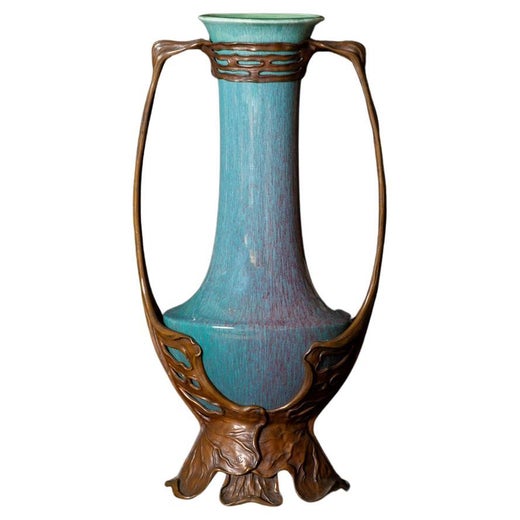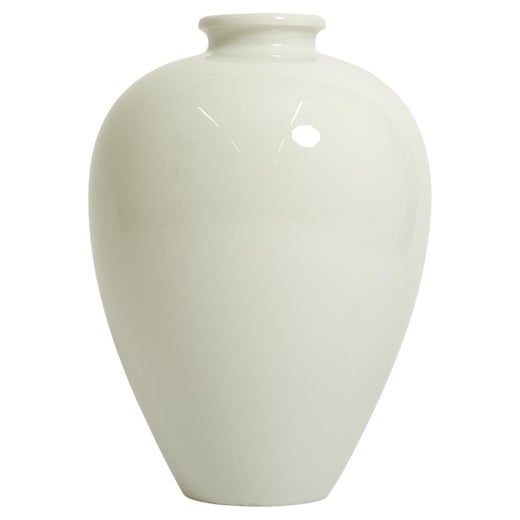Important Otto Eckmann Waterlily Vase Jugendstil Patinated Bronze KPM Stoneware
About the Item
- Creator:Otto Schulz (Manufacturer),Otto Eckmann (Designer),Königliche Porzellan-Manufaktur (KPM) (Manufacturer)
- Dimensions:Height: 20.48 in (52 cm)Width: 11.03 in (28 cm)Depth: 6.3 in (16 cm)
- Style:Jugendstil (Of the Period)
- Materials and Techniques:
- Place of Origin:
- Period:1900-1909
- Date of Manufacture:1900
- Condition:Wear consistent with age and use.
- Seller Location:Nierstein am Rhein, DE
- Reference Number:1stDibs: LU2625312004743
Otto Eckmann
Exuding the boundless energy of the Munich art scene in the 1890s, Eckmann was the face of the Jugendstil movement. He created the Eckmann Type for the Karl Klingspor printers in Offenbach, a popular typeface of the day, and his illustrated work graced the cover of the art periodical, Jugend, 5 times. The swan, a favorite and recurring image which Eckmann employed in tapestries, textiles and prints, came to be the symbol of Jugendstil, itself. His career may have begun as a painter; however, by 1894 Eckmann swore off this artistic tie to fully embrace the Applied Arts by auctioning off every one of his paintings. In an accompanying letter to the auctioneer - no doubt typed using Eckmann typeface - his sentiments which he expressed for his paintings were “may we never meet again.” Eckmann’s output ran the gamut of the Applied Arts: from tapestries; color woodcuts for which he cut his blocks and made his inks; stained glass; jewelry; metal and silver objects; to furniture; designs for women’s fashion; book design and ceramics.
Königliche Porzellan-Manufaktur (KPM)
Known by just KPM, the Königliche Porzellan-Manufaktur company has been synonymous with exquisite porcelain works fit for nobility and royalty for over 200 years. KPM porcelain plates, centerpieces and sculptures are painstakingly formed through ages-old techniques and meticulously painted by hand, producing one-of-a-kind quality.
KPM began in Berlin in 1763, founded by King Frederick II of Prussia, after two other entrepreneurs had been unsuccessful in establishing porcelain manufacturing companies in Germany. In 1878, KPM developed a relationship with the Chemical-Technical Research Institute and its director, Hermann Seger. This partnership gave KPM early access to advances in porcelain production and coloration.
KPM flourished under the banner of royal ownership until 1918, when it became a state-run entity after the monarchy was disbanded following Germany’s loss in World War I. With the rise of the Nazi Party in the 1930s, many of the company’s top designers and directors were dismissed, denied exhibitions or forced to flee Germany due to Jewish heritage or loyalty to Jewish colleagues. In 1943, an Allied bombing raid destroyed the KPM factory, and the company was not reestablished until after the war.
KPM reopened in Franconia and began producing porcelain wares. Some staff also worked on reconstructing the historic KPM site in Berlin. In 1957, manufacturing returned to the original company premises.
KPM rebounded over the next few decades. In 2006, in a step to privatize companies throughout the country, German financier Jörg Woltmann bought the organization.
Since its privatization, the company has opened many galleries and shops around Germany and has worked in collaboration with notable brands like Bottega Veneta and Bugatti motor company in recent years.
Although rooted in the Rococo style, KPM has adapted its craft to meet the current trends, all while maintaining the highest levels of excellence throughout its centuries of operation. It continues to produce lavish, elegant porcelain works for elite clientele the world over.
On 1stDibs, browse a vast selection of Königliche Porzellan-Manufaktur serveware, decorative objects, lighting and more.
You May Also Like
Antique Early 1900s German Jugendstil Vases
Bronze
Antique Early 1900s German Jugendstil Vases
Bronze
Antique Early 19th Century German Jugendstil Vases
Bronze
Vintage 1910s German Jugendstil Vases
Porcelain
Antique Early 1900s Jugendstil Vases
Porcelain
Antique Early 1900s Jugendstil Vases
Porcelain
Antique Early 1900s German Art Nouveau Vases
Bronze
Vintage 1910s Austrian Jugendstil Vases
Bronze
Antique Early 1900s Austrian Jugendstil Vases
Bronze
Vintage 1970s German Mid-Century Modern Vases
Porcelain

